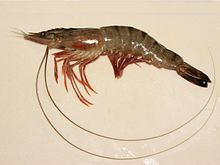| Penaeidae | |
|---|---|
 | |
| Penaeus monodon | |
| Scientific classification | |
| Kingdom: | Animalia |
| Phylum: | Arthropoda |
| Subphylum: | Crustacea |
| Class: | Malacostraca |
| Order: | Decapoda |
| Superfamily: | Penaeoidea |
| Family: | Penaeidae Rafinesque, 1815 |
Penaeidae is a family of marine crustaceans in the suborder Dendrobranchiata, which are often referred to as penaeid shrimp or penaeid prawns. The Penaeidae contain many species of economic importance, such as the tiger prawn, whiteleg shrimp, Atlantic white shrimp, and Indian prawn. Many prawns are the subject of commercial fishery, and farming, both in marine settings, and in freshwater farms. Lateral line–like sense organs on the antennae have been reported in some species of Penaeidae.[1] At 210 metres per second (760 km/h), the myelinated giant interneurons of pelagic penaeid shrimp have the world record for impulse conduction speed in any animal.[2]
Genera
Of the 48 recognised genera in the family Penaeidae, 23 are known only from the fossil record (marked †):[3]
- † Albertoppelia Schweigert & Garassino, 2004
- † Ambilobeia Garassino & Pasini, 2002
- † Antrimpos Münster, 1839
- Artemesia Bate, 1888
- Atypopenaeus Alcock, 1905
- † Bombur Münster, 1839
- † Bylgia Münster, 1839
- † Carinacaris Garassino, 1994
- † Cretapenaeus Garassino, Pasini & Dutheil, 2006
- † Drobna Münster, 1839
- † Dusa Münster, 1839
- Farfantepenaeus Burukovsky, 1997
- Fenneropenaeus Pérez Farfante, 1969
- Funchalia Johnson, 1868
- † Hakelocaris Garassino, 1994
- Heteropenaeus De Man, 1896
- † Ifasya Garassino & Teruzzi, 1995
- † Koelga Münster, 1839
- † Libanocaris Garassino, 1994
- Litopenaeus Pérez Farfante, 1969
- † Longichela Garassino & Teruzzi, 1993
- † Longitergite Garassino & Teruzzi, 1996
- † Macropenaeus Garassino, 1994
- Macropetasma Stebbing, 1914
- Marsupenaeus Tirmizi, 1971
- Megokris Pérez Farfante & Kensley, 1997
- Melicertus Rafinesque, 1814
- Metapenaeopsis Bouvier, 1905
- Metapenaeus Wood-Mason & Alcock, 1891
- † Microchela Garassino, 1994
- † Micropenaeus Bravi & Garassino, 1998
- Parapenaeopsis Alcock, 1901
- Parapenaeus Smith, 1885
- Pelagopenaeus Pérez Farfante & Kensley, 1997
- Penaeopsis Bate, 1881
- Penaeus Fabricius, 1798
- Protrachypene Burkenroad, 1934
- † Pseudobombur Secretan, 1975
- † Pseudodusa Schweigert & Garassino, 2004
- † Rauna Münster, 1839
- † Rhodanicaris Van Straelen, 1924
- Rimapenaeus Pérez Farfante & Kensley, 1997
- † Satyrocaris Garassino & Teruzzi, 1993
- Tanypenaeus Pérez Farfante, 1972
- Trachypenaeopsis Burkenroad, 1934
- Trachypenaeus Alcock, 1901
- Trachysalambria Burkenroad, 1934
- Xiphopenaeus Smith, 1869
References
- ^ E. J. Denton; John Gray (1985). "Lateral-line-like antennae of certain of the Penaeidea (Crustacea, Decapoda, Natantia)". Proceedings of the Royal Society B. 226 (1244): 249–261. doi:10.1098/rspb.1985.0094.
- ^ Ke Hsu & Susumu Terakawa (1998). "Fenestration in the myelin sheath of nerve fibers of the shrimp: A novel node of excitation for saltatory conduction". Journal of Neurobiology. 30 (3): 397–409. doi:10.1002/(SICI)1097-4695(199607)30:3<397::AID-NEU8>3.0.CO;2-#. PMID 8807532.
- ^ Sammy De Grave; N. Dean Pentcheff; Shane T. Ahyong; et al. (2009). "A classification of living and fossil genera of decapod crustaceans" (PDF). Raffles Bulletin of Zoology. Suppl. 21: 1–109.